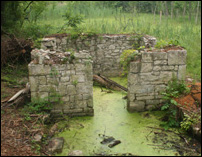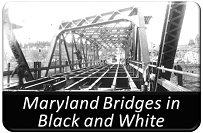Maryland has long been a cultural crossroads. For at least 12,000 years people have left traces of their existence in the form of settlements, roads and artifacts. The physical remains of our past are known as cultural resources and reveal how Native Americans, European Americans, and African Americans, among others, used Maryland's diverse landscape.

Each year, the Maryland Department of Transportation State Highway Administration (SHA) coordinates hundreds of projects that range from sign installation to bridge replacement to new highway construction. In accordance with federal laws, our cultural resources team of architectural historians and archaeologists evaluate proposed construction impacts on buildings, historic districts, roadway structures, and archaeological sites, ensuring adverse impacts are avoided whenever possible and minimized or mitigated if the impacts are unavoidable.
The majority of SHA projects are subject to Section 106 of the National Historic Preservation Act. To learn more about Section 106 review for SHA projects, and the role of citizens and consulting parties, view the
Citizens’ Guide to Section 106 Consultation in Maryland.
Programmatic Agreement and Minor Projects
SHA reviews numerous projects with limited potential to affect historic resources each year.
As part of SHA’s responsibility to consider historic and cultural resources in our actions, SHA amended its
Programmatic Agreement (PA) for Section 106 of the National Historic Preservation Act with the Federal Highway Administration (FHWA), the Maryland Historical Trust (MHT), the Maryland Transportation Authority (MDTA), and the Advisory Council on Historic Preservation (ACHP) in 2021. This current version of the PA continues to delegate authority from FHWA to SHA and provides for streamlined review procedures for minor projects, and other actions with limited potential to affect historic resources. Additionally, FHWA-funded local agency programs administered by SHA and reviews for MDTA actions are included in the PA.
As part of the PA, SHA makes a report of these minor project reviews available quarterly. To receive these reports, email
[email protected].
Local Public Agency Programs
The 2021 PA allows for federal-aid local transportation projects to follow the same streamlined Section 106 review process outlined in the PA. SHA will lead Section 106 reviews for local public agency transportation projects. Appendix 1 and 2 of the amended PA list the project categories that may qualify for the streamlined, exempted review processes. Attachment 1 details how the review process will work and the responsibilities of state and local public agencies in this process.
In 2021, SHA held an online training session in this process for local public agency personnel involved in project planning. The
webinar recording and
PowerPoint slides , and a list of
Frequently Asked Questions are now available to view online.
For more information about local public agency transportation projects, please see FHWA’s
Environmental Review Toolkit for historic preservation; FHWA’s
guidance on Section 106 for local public agencies; the Advisory Council on Historic Preservation’s
overview of the Section 106 process, and SHA’s
guidance for local public agencies and sub-recipients of federal funds.
Archaeology
SHA archaeologists study the past through the physical remains people left behind. These remains can be as small as a pottery fragment or as large as a sunken ship. Archeologists carefully excavate, record, and interpret artifacts that explain the activities of people who lived in Maryland but left few or no written records.
African American Archaeology Historic Context Needs Assessment
To better understand archaeological resources about our roadway system, SHA has developed the
African American Context Needs Assessment, exploring currently available information about African American archaeological sites in Maryland. It proposes some initial steps to develop a practical framework toward better interpretation and evaluation of these sites, particularly within a transportation context. The project has three major components that can be used as standalone resources: compiled GIS data for all known African American sites in Maryland, proposed periods of significance and a proposed site typology for African American archaeological sites in the state.
Maryland’s Highways started with Maryland’s Native Communities
Did you know that many Maryland State Highways originated as Native American trails and paths? Colonial settlers sometimes relied on well-worn paths forged by indigenous Marylanders as a basis for colonial Maryland’s first formalized roads and, in turn, some of these roads have become part of our state highway system – as many as 35, in fact. SHA recently partnered indigenous Marylanders and a consultant team on a study,
Native American Trails to Historic Roads: Historic Context and Methodology, to identify these roads.
Architectural History
The hallmarks of Maryland’s diverse cultural heritage are everywhere - from the 17th century signposts of Maryland’s settlers to mid-twentieth century suburban developments. SHA architectural historians explain our past by combining the investigation of historic standing structures with the interpretation of historic documents. SHA architectural historians partner with the
Maryland Historical Trust (MHT) to survey, identify, and record Maryland’s historic standing structures in our mission to implement Section 106 of the
National Historic Preservation Act (NHPA), the
National Environmental Policy Act(NEPA) and the
Maryland Environmental Policy Act (MEPA).
Civil Rights History on Maryland State Roads
SHA developed the Maryland State Roads Civil Rights Context to identify and evaluate resources associated with civil rights activities along state roads in Maryland. The context encompasses multiple groups, communities and movements that sought to secure legal and social equity in the state, starting in 1942 and continuing into the 1980s. The context focuses on protests, marches and motorcades that occurred along state routes but establishes a framework for survey and evaluation applicable throughout the state.
Maryland Railroads
To enable accurate location, identification and evaluation of railroad resources throughout Maryland, SHA has developed the “Maryland Railroads Statewide Historic Context.” The completed context provides an overview of Maryland railroad history from the establishment of the Baltimore & Ohio Railroad in 1827 to the creation of Amtrak in 1976 and introduces a resource typology and glossary with standardized terminology. To streamline survey and evaluation, the context identifies 10 important Maryland railroads most likely to be eligible for the
National Register of Historic Places (NRHP), along with common resource types unlikely to have significance. SHA frequently encounters railroad resources during cultural resources surveys, and with these steps, the context ensures that efforts are focused on the most relevant and important resources, allowing SHA and its partners throughout Maryland to remain consistent and accurate when assessing the state’s railroad history.
SHA Historic Structures
Additional Resources
Historic Bridges

The Parkton Stone Arch Bridge was constructed in 1809. It is the oldest bridge in
Maryland still in use. It is on MD 463 over Little Gunpowder Falls in Parkton, Baltimore County.
Bridges hold a special place in our cultural landscape. They link to our past, other communities and economic opportunity. Maryland has many historic bridges eligible for inclusion on the National Register of Historic Places. In keeping with the National Historic Preservation Act and with our own commitment to protecting Maryland's unique structures, SHA works with the Maryland Historical Trust to identify historic bridges and small structures throughout the state.
Click here to view the
Maryland Historic Highway Bridges brochure.
Below are links to publications with detailed information about Maryland's historic bridges:
Bridging Maryland, Becoming Engineers Historic Bridge Lesson Plans
SHA has prepared the Bridging Maryland, Becoming Engineers Lesson Plans for free use to aid educators in guiding students in learning about basic bridge engineering and the engineering design process using historic bridge examples and hands-on problem solving. Lesson plans are available for kindergarten through third grade, as well as fourth through eighth grades.

Click here to access an interactive map of Maryland bridges and archival photographs.
Archived Bridge Photography